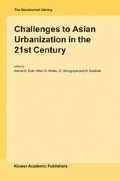Conclusion
Post independence growth has begun to obliterate the structural configuration evolved during the British Colonial Period. The Fort area is now a center of commerce and finance with much of the colonial administrative functions moved outward toward the periphery of the city. While what might be called the classic models of the South Asian city can still be applied, their utility becomes less and less with continuing urban growth. The port city models are most useful in discussions of Colombo’s inner sections. Outward expansion has tended to make both types of models less appropriate. Perhaps it is time for new models to be proposed.
Access this chapter
Tax calculation will be finalised at checkout
Purchases are for personal use only
Preview
Unable to display preview. Download preview PDF.
References
Alam, S. (1965). Hyderabad — Secunderabad: Twin Cities, A Study in Urban Geography. New Delhi: Allied Publishers.
Brush, John. (1968). “Spatial Patterns of Population in Indian Cities”, Geographical Review. 58: 3:362–391.
Dutt, Ashok K. (1993). “Cities of South Asia” pp. 351–158 in Brunn, Stanley D. and Jack F. William (eds.). Cities of the World. New York: Harper Collins.
Dutt, Ashok K. and Ruhul Amin. (1986). “Toward a Typology of South Indian Cities”, National Geographical Journal of India, 32:1:30–39
Dutt, Ashok K., Yichun Xie, Frank J. Costa and Zhengmao Yang. (1994). “City Forms of China and India in Global Perspective”. pp. 25–51 in Dutt, Ashok K., Frank J. Costa, Surinder Aggarwal and Allen G. Noble, (eds.) The Asian City: Processes of Development, Characteristics and Planning. Dordrecht: Kluwer Academic Publishers
Grewal, Retta. (1991). “Urban Morphology Under Colonial Rule”. pp. 173–190 in Banga, Indu, (ed.). The City in Indian History. New Delhi: Manohar.
Harris, Chauncey D. and Edward L. Ullman. (1945). “The Nature of Cities”, Annals of the American Academy of Political and Social Science, 242:7–17
Hoyt, Homer. (1939), The Structure and Growth of Residential Neighborhoods in American Cities. Washington: Government Printing Office.
McGee, T.G. (1967). The Southeast Asian City. New York: Praeger.
Noble, Allen G. (1998) “Using Descriptive Models to Understand South Asian Cities”, Education About Asia, 3:3:24–29.
Panditharatne, B.L. (1964). “The Functional Zones of the Colombo City”, University of Ceylon Review. 22:1–2:138–164.
Panditharatne, B.L. (1976). “Growth, Morphology and Ethnic Characteristics of Colombo Agglomera tion”, pp. 427–453 in Manzoor Alam, S. and V.V. Pokshishkevy, (eds.). Urbanization in Developing Countries. Hyderabad: Osmania University.
Park, Robert E., E. W. Burgess and R. D. McKenzie. (1925). The City. Chicago: University of Chicago Press.
Perera, Nihal. (1998). Society and Space: Colonialism, Nationalism, and Postcolonial Identity in Sri Lanka. Boulder: Westview Press.
Saxena, Sudha. (1970). Trends in Urbanization in Uttar Pradesh. Agra: Satish Book Enterprise.
Singh, Alok K. (1988). “Typology and Structural Models of Urban Centres in South Mirzapur”, National Geographical Journal of India, 34:3:249–255.
Singh, R. L. (1955). Banaras: A Study of Urban Geography. Banaras: Nand Kishore.
Smailes, Arthur E. (1969). “The Indian City,” Geographische Zeitschrift, 57:177–190.
Soffer, Arnon and Shimon Stern. (1986). “The Port City: a sub-group of the Middle-Eastern city model”, Ekistics. 53:316/317:102–110.
Taneja, K. L. (1971). Morphology of Indian Cities. Varanasi: National Geographical Society of India.
Vance, James E., Jr. (1977). This Scene of Man: The Role and Structure of the City in the Geography of Western Civilization. New York: Harper.
Editor information
Editors and Affiliations
Rights and permissions
Copyright information
© 2004 Springer Science + Business Media, Inc.
About this chapter
Cite this chapter
Noble, A.G., Panditharatne, B.L. (2004). Colombo and the Pattern of South Asian and Port City Models. In: Dutt, A.K., Noble, A.G., Venugopal, G., Subbiah, S. (eds) Challenges to Asian Urbanization in the 21st Century. The GeoJournal Library, vol 75. Springer, Dordrecht. https://doi.org/10.1007/1-4020-2531-9_4
Download citation
DOI: https://doi.org/10.1007/1-4020-2531-9_4
Publisher Name: Springer, Dordrecht
Print ISBN: 978-1-4020-1576-2
Online ISBN: 978-1-4020-2531-0
eBook Packages: Springer Book Archive

